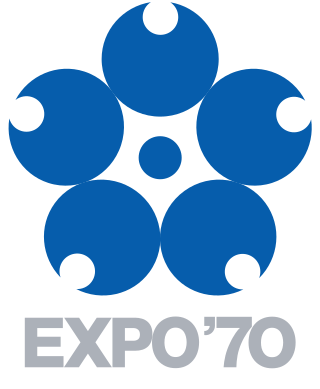
The 1967 International and Universal Exposition, commonly known as Expo 67, was a general exhibition from April 28 to October 29, 1967. It was a category one world's fair held in Montreal, Quebec, Canada. It is considered to be one of the most successful World's Fairs of the 20th century with the most attendees to that date and 62 nations participating. It also set the single-day attendance record for a world's fair, with 569,500 visitors on its third day.

The National Film Board of Canada is Canada's public film and digital media producer and distributor. An agency of the Government of Canada, the NFB produces and distributes documentary films, animation, web documentaries, and alternative dramas. In total, the NFB has produced over 13,000 productions since its inception, which have won over 5,000 awards. The NFB reports to the Parliament of Canada through the Minister of Canadian Heritage. It has bilingual production programs and branches in English and French, including multicultural-related documentaries.
Roman Kroitor was a Canadian filmmaker who was known as a pioneer of Cinéma vérité, as the co-founder of IMAX, and as the creator of the Sandde hand-drawn stereoscopic 3D animation system. He was also the original inspiration for The Force. His prodigious output garnered numerous awards, including two BAFTA Awards, three Cannes Film Festival awards, and two Oscar nominations.

The Japan World Exposition, Osaka, 1970 or Expo 70 was a world's fair held in Suita, Osaka Prefecture, Japan between March 15 and September 13, 1970. Its theme was "Progress and Harmony for Mankind." In Japanese, Expo '70 is often referred to as Ōsaka Banpaku (大阪万博). It was the first world's fair held in Japan and in Asia.
21-87 is a 1963 Canadian abstract montage-collage film created by Arthur Lipsett that lasts 9 minutes and 33 seconds. The short, produced by the National Film Board of Canada, is a collage of snippets from discarded footage found by Lipsett in the editing room of the National Film Board, combined with his own black and white 16 mm footage which he shot on the streets of Montreal and New York City, among other locations.
Universe is a 1960 black-and-white documentary short film made in 1960 by Roman Kroitor and Colin Low for the National Film Board of Canada, which says that the film "creates on the screen a vast, awe-inspiring picture of the universe as it would appear to a voyager through space. Realistic animation takes you into far regions of space, beyond the reach of the strongest telescope, past Moon, Sun, and Milky Way into galaxies yet unfathomed."
Donald Code Brittain, was a film director and producer with the National Film Board of Canada.
IMAX Corporation is a Canadian theatre company which designs and manufactures IMAX cameras and projection systems as well as performing film development, production, post-production and distribution to IMAX-affiliated theatres worldwide. Founded in Montreal in 1967, it has headquarters in the Toronto area, and operations in New York City and Los Angeles.
Stephen Low is a Canadian film director and screenwriter who works extensively in the IMAX and IMAX 3D film formats. Based in Montreal, Quebec, over his 30-plus year career Low has directed numerous award-winning film documentaries including Challenger: An Industrial Romance (1980), Beavers (1988), Titanica (1991), Super Speedway (1997), Volcanoes of the Deep Sea (2003), Fighter Pilot: Operation Red Flag (2004), Ultimate Wave Tahiti 3D (2010), Legends of Flight 3D (2010), Rescue 3D (2011), Rocky Mountain Express (2011) and Aircraft Carrier (2017).
Colin Archibald Low was a Canadian animation and documentary filmmaker with the National Film Board of Canada (NFB). He was known as a pioneer, one of Canada's most important filmmakers, and was regularly referred to as "the gentleman genius". His numerous honors include five BAFTA awards, eight Cannes Film Festival awards, and six Academy Award nominations.
Transitions is the first full-colour 3D IMAX film, created for the Canada Pavilion at Expo 86, co-directed by Colin Low and Tony Ianzelo and produced by the National Film Board of Canada. It was built upon We Are Born of Stars created for Expo '85 in Tskuba, Japan, which used anaglyph 3D. The film is also notable for the first use of stereoscopic computer animation.
Momentum was the first film shot and released in the IMAX HD film format, which ran at 48 frames per second, and was also one of the first films to use Ambisonic surround sound. The film was produced for the Canada pavilion at Seville Expo '92 by National Film Board of Canada, by the same creative team that made the 1986 3D IMAX film Transitions for Expo 86. The film takes viewers across Canada, demonstrating the ability of the 48 frame/s process to portray motion on the giant IMAX screen with reduced strobing.
Eldon Davis Rathburn was a Canadian film composer who scored over 250 films during his thirty-year tenure as a staff composer at the National Film Board of Canada. Known as "the dean of Canadian film composers", Rathburn composed music for documentaries, short films, as well as such feature films as Drylanders (1963), Nobody Waved Good-bye (1964), Waiting for Caroline (1969), Cold Journey (1975), and Who Has Seen the Wind (1977). Rathburn was the subject of a 1995 NFB documentary by Louis Hone titled Eldon Rathburn: They Shoot... He Scores.

The Expo 67 International and Universal Exposition featured 90 pavilions representing Man and His World, on a theme derived from Terre des Hommes, written by the famous French pilot Antoine de Saint-Exupéry.

Walking is a 1968 Canadian animated short film directed and produced by Ryan Larkin for the National Film Board of Canada, composed of animated vignettes of how different people walk.
Hugh O'Connor was a Canadian director and producer who worked for the National Film Board of Canada (NFB). His best- known film is the ground-breaking In the Labyrinth (1967), but his promising career ended shortly after that film's release when he was murdered while filming in Kentucky.
SANDDE was a software and hardware system, developed primarily by IMAX Corporation, designed to create hand-drawn, stereoscopic 3D animation content. SANDDE is an acronym for "Stereoscopic ANimation Drawing DEvice" and is a play on the Japanese term for "3D", which is pronounced "San-D" (三デ).
Eskimo Artist: Kenojuak is a 1964 Canadian short film about Inuk artist Kenojuak Ashevak, directed by John Feeney and produced by the National Film Board of Canada (NFB). It won the BAFTA Award for Best Short Film in 1964 and, in 1965, was nominated for the Academy Award for Best Documentary Short Film.

Thomas Cullen Daly was a Canadian film producer, film editor and film director, who was the head of Studio B at the National Film Board of Canada (NFB).
Stanley Jackson (1914-1981) was a Canadian film director, producer, writer and narrator with the National Film Board of Canada (NFB).







